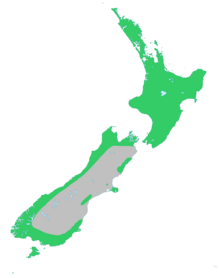
Back صنوبر أبيض Arabic Dacrycarpus dacrydioides CEB Dacrycarpus dacrydioides Czech Neuseeländische Warzeneibe German Dacrycarpus dacrydioides Spanish Kõrge pisarviljak Estonian Dacrycarpus dacrydioides Finnish Dacrycarpus dacrydioides French Dacrycarpus dacrydioides Icelandic Dacrycarpus dacrydioides Italian
| Kahikatea | |
|---|---|

| |
| Mature kahikatea tree | |
| Scientific classification | |
| Kingdom: | Plantae |
| Clade: | Tracheophytes |
| Clade: | Gymnospermae |
| Division: | Pinophyta |
| Class: | Pinopsida |
| Order: | Araucariales |
| Family: | Podocarpaceae |
| Genus: | Dacrycarpus |
| Species: | D. dacrydioides
|
| Binomial name | |
| Dacrycarpus dacrydioides | |

| |
| Natural range of D. dacrydioides | |
| Synonyms[2] | |
Dacrycarpus dacrydioides, commonly known as kahikatea (from Māori) and white pine, is a coniferous tree endemic to New Zealand. A podocarp, it is New Zealand's tallest tree, gaining heights of 60 m over a life span of 600 years. It was first described botanically by the French botanist Achille Richard in 1832 as Podocarpus dacrydioides, and was given its current binomial name Dacrycarpus dacrydioides in 1969 by the American botanist David de Laubenfels. Analysis of DNA has confirmed its evolutionary relationship with other species in the genera Dacrycarpus and Dacrydium.
In Māori culture, it is an important source of timber for the building of waka and making of tools, of food in the form of its berries, and of dye. Its use for timber and its damp fertile habitat, ideal for dairy farming, have led to its decimation almost everywhere except South Westland.
Kahikatea seeds have fleshy structures called receptacles attached to them, which encourage birds such as kererū and tūī to eat them and disperse the seeds. The water storage ability of these structures may also act to protect seeds from drying out. It supports many smaller plants in its own branches, which are called epiphytes; 100 different species have been recorded on one tree alone.
- ^ Thomas, P. (2013). "Dacrycarpus dacrydioides". IUCN Red List of Threatened Species. 2013: e.T42443A2980535. doi:10.2305/IUCN.UK.2013-1.RLTS.T42443A2980535.en. Retrieved 19 November 2021.
- ^ Cite error: The named reference
:0was invoked but never defined (see the help page).
